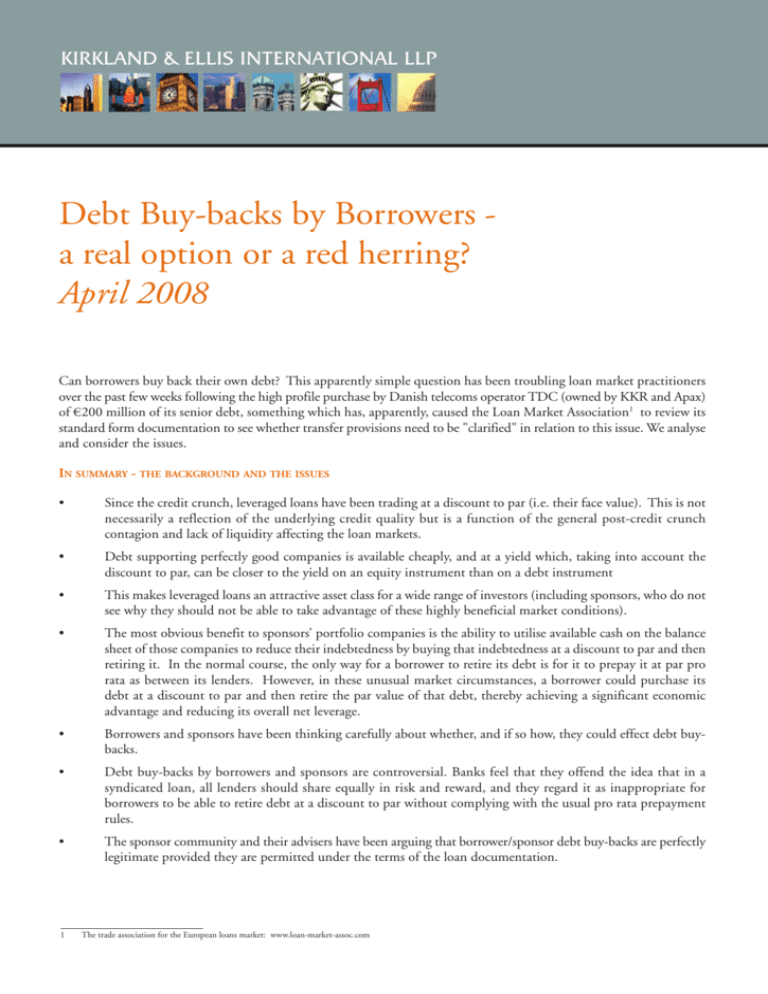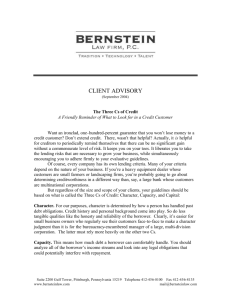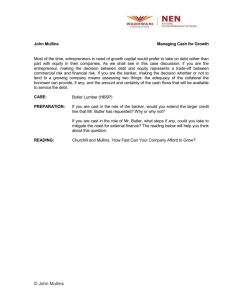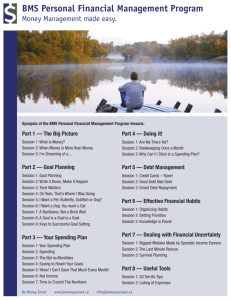
KIRKLAND & ELLIS INTERNATIONAL LLP
Debt Buy-backs by Borrowers a real option or a red herring?
April 2008
Can borrowers buy back their own debt? This apparently simple question has been troubling loan market practitioners
over the past few weeks following the high profile purchase by Danish telecoms operator TDC (owned by KKR and Apax)
of €200 million of its senior debt, something which has, apparently, caused the Loan Market Association1 to review its
standard form documentation to see whether transfer provisions need to be "clarified" in relation to this issue. We analyse
and consider the issues.
IN SUMMARY - THE BACKGROUND AND THE ISSUES
•
Since the credit crunch, leveraged loans have been trading at a discount to par (i.e. their face value). This is not
necessarily a reflection of the underlying credit quality but is a function of the general post-credit crunch
contagion and lack of liquidity affecting the loan markets.
•
Debt supporting perfectly good companies is available cheaply, and at a yield which, taking into account the
discount to par, can be closer to the yield on an equity instrument than on a debt instrument
•
This makes leveraged loans an attractive asset class for a wide range of investors (including sponsors, who do not
see why they should not be able to take advantage of these highly beneficial market conditions).
•
The most obvious benefit to sponsors’ portfolio companies is the ability to utilise available cash on the balance
sheet of those companies to reduce their indebtedness by buying that indebtedness at a discount to par and then
retiring it. In the normal course, the only way for a borrower to retire its debt is for it to prepay it at par pro
rata as between its lenders. However, in these unusual market circumstances, a borrower could purchase its
debt at a discount to par and then retire the par value of that debt, thereby achieving a significant economic
advantage and reducing its overall net leverage.
•
Borrowers and sponsors have been thinking carefully about whether, and if so how, they could effect debt buybacks.
•
Debt buy-backs by borrowers and sponsors are controversial. Banks feel that they offend the idea that in a
syndicated loan, all lenders should share equally in risk and reward, and they regard it as inappropriate for
borrowers to be able to retire debt at a discount to par without complying with the usual pro rata prepayment
rules.
•
The sponsor community and their advisers have been arguing that borrower/sponsor debt buy-backs are perfectly
legitimate provided they are permitted under the terms of the loan documentation.
1
The trade association for the European loans market: www.loan-market-assoc.com
KIRKLAND & ELLIS INTERNATIONAL LLP
WHY MIGHT BORROWERS WISH TO BUY THEIR OWN DEBT?
In market conditions where debt is trading at or above par, a borrower under a syndicated loan agreement with excess
cash available to it might decide that it made economic sense to use that cash to retire some of its indebtedness, thereby
reducing its leverage and easing the cashflow burden associated with paying interest on the debt that is being retired.
Under loan documentation that is based on, or is compliant with, the LMA standard form agreements, the only way to
prepay debt is to prepay that debt in order of seniority2 at par3 pro rata to lenders’ participations4.
Current market conditions are not "normal". Debt, even for perfectly good unimpaired credits, is trading at, or is being
offered to prospective purchasers at, a significant discount to par (typically between 15% and 25% below par). In those
circumstances, borrowers and sponsors have been considering whether it makes sense for them to use available cash to
purchase some of their own debt at this sort of price and either to hold that debt for yield or to forgive the debt, thereby
achieving a much more advantageous economic result than were they to retire the debt by prepaying it at par pro rata
as between lenders - why pay l00p in the £ to reduce debt when you could achieve the same reduction in debt burden
at a discounted price?
HOW DOES THIS WORK IN PRACTICE?
Let's suppose that a borrower owes a debt of £1,000 to a syndicate of 10 banks (all of whom participate equally in the
loan), that brokers in the secondary market are quoting a price of 75p in the £ for this debt, that the borrower has £500
of cash available which it is free to use as it sees fit, and that it wishes to use that cash to reduce its debt burden.
•
Prepayment Route: Our borrower could make a voluntary prepayment of its loan - each lender would receive
£50, and the debt would be reduced by £500.
•
Debt Purchase Route: Alternatively, our borrower could ask a secondary loans market broker to find lenders
in its syndicate who are willing to sell it some or all of their debt at a discount to par. The broker would make
the necessary phone calls, and find lenders who are willing to sell at, let's say, 75p in the £. The borrower would
then use its spare £500 to buy the debt offered to it, and the debt would subsequently be forgiven. What is the
result? The result is that the borrower has bought debt with a nominal/par value of £625 for a cash outlay of
£500, and has reduced its debt burden by £625, not £500 as in the prepayment example above.
So, the advantages of being able to buy back debt at a discount to par, as opposed to repaying that debt at par, are
obvious.
WHAT'S THE CATCH?
There are a couple of potential catches at least.
First, the borrower has to be sure that the provisions of its loan documentation permit it to make the debt purchase, and
that there are no adverse tax or regulatory consequences of making the purchase.
2
Senior debt first, then junior debt (but only after senior debt has been repaid in full)
3
"Par" means the face value of the debt - thus, if a loan of £100 was to be repaid at par, £100 would need to be paid back to the lender. There may also be prepayment penalties payable.
4
Under a syndicated loan agreement, loans are initially made by one or two banks ("underwriters") and are then "syndicated" by being sliced up into "participations" which are "sold"
to lenders active in the syndicated loans market so that the loan ends up in fact being a series of loans made by the syndicate members.
www.kirkland.com | 2
KIRKLAND & ELLIS INTERNATIONAL LLP
Secondly, the borrower needs to consider what the consequences of becoming a holder of its debt are - it is arguable
(though not free from doubt) that debt purchased by the borrower of that debt is not extinguished until it actually
becomes due for payment (see “The legal effect of debt buy-backs” below), and so some slightly perverse consequences
can flow from a borrower becoming a lender to itself.
We examine both of these issues in more detail below.
IT'S JUST NOT CRICKET!
The bigger and more controversial issue is whether debt buy-backs by borrowers somehow go against the spirit and rule
of syndicated lending.
Bankers have been heard to complain that the TDC buy-back "violates the four principles of senior lending: seniority,
priority, risk sharing and security [in this case, security over future cash flows]5", and there is no question that debt buybacks by borrowers are controversial because they could be construed as a prepayment which does not comply with the
rules for prepayment set out in the loan documentation, especially so if the debt that is being bought is
junior/subordinated debt.
The counter to that argument is that it's a free market and, provided the buy-back is permitted under the loan
documentation, there is nothing to stop a willing seller from selling its debt participation to a willing purchaser, and that
purchaser can just as easily be the borrower, or an affiliate of the borrower, as anyone else. Additionally, in the current
market conditions, any reduction in the leverage of a company should be welcomed by creditors of that company.
SO - ARE DEBT BUY-BACKS PERMITTED UNDER STANDARD EUROPEAN LOAN DOCUMENTATION?
Lenders and borrowers are free to agree whatever terms they want between themselves, and so there really is no such thing
as a "standard" European loan agreement. However, the LMA has developed what are now widely respected, and widely
used, standard form loan agreements for use in both the investment grade and leveraged finance markets. The chances
are that in the majority of cases, the "boilerplate" provisions6 in a European syndicated loan agreement will be based on
or compliant with the LMA standard forms. Assuming that is the case, the key question is whether the borrower is a
person to whom the loan is permitted to be transferred under the terms of the loan agreement7.
IS THE BORROWER A PERMITTED TRANSFEREE?
The LMA standard form loan agreement8 provides that a lender may transfer its rights and/or obligations to "another
bank or financial institution or to a trust, fund or other entity which is regularly engaged in or established for the purpose of
making, purchasing or investing in loans, securities or other financial assets".
It is a question of fact whether a borrower will fall within that language. If an express corporate purpose of the borrower
is, or can be construed as, "making, purchasing or investing in loans, securities or other financial assets", then the
borrower is a permitted transferee regardless of whether that is something that it does regularly or in the ordinary course
5
Debtwire EU Weekly Report, 28th March 2008.
6
Those provisions which are mechanical and/or non-controversial and which are not usually negotiated in detail or at all
7
Loan agreements typically seek to restrict the identity of persons to whom the loan can be transferred. These restrictions are generally intended to protect the borrower and to ensure
that the loan does not end up in the hands of someone whose interests might be adverse to those of the borrower (such as a business competitor for example). It is ironic to note that
the push to broaden the scope of the permitted transferee language came from the bank market, and was driven by their desire to re-package loans into structured investment vehicles
in order to get them off-balance sheet.
8
Form of Facility Agreement for Leveraged Finance Transactions, draft dated February 2008.
www.kirkland.com | 3
KIRKLAND & ELLIS INTERNATIONAL LLP
of its business9. If that is not an express or implied corporate purpose of the borrower, then it is a question of fact whether
the borrower "regularly engages in" or was "established for the purpose of" making, purchasing or investing in loans,
securities or other financial assets.
The analysis will depend on the facts, and one cannot make generalisations as to whether a particular borrower will fall
within the permitted transferee language.
ARE THERE OTHER PROVISIONS OF THE LOAN DOCUMENTATION WHICH COULD PREVENT THE BUY-BACK?
Assuming that the borrower is a permitted transferee, it will then need to consider whether there are other provisions of
the loan documentation which could prohibit a transfer of debt to it.
The most obviously relevant are those which seek to restrict the activities of the borrower to those of a holding company.
For example, the LMA standard form stops the borrower from trading, carrying on any business, owning any assets or
incurring any liabilities with exceptions for the provision of administrative services, intra-group activities, and incurring
the professional fees of advisers.
Taken at face value, these would appear to prohibit debt buy-backs by borrowers. Whether they do so or not will require
a careful analysis of the relevant documentation. It is at least arguable that the acquisition by a borrower of debt owed
by itself is an intra-group activity, so that the debt purchase would fall within the intra-group exceptions to these
provisions.
THE LEGAL EFFECT OF DEBT BUY-BACKS
OK, so a borrower buys back its debt - what happens then?
It is widely thought that under English law, you cannot owe a debt to yourself, so that if a borrower buys back its own
debt, that debt is automatically extinguished.
This is open to doubt.
It is at least arguable that a debt purchased by the borrower of that debt is not extinguished until it actually becomes due
for payment. In just the same way that a bond issuer can buy, sell, invest or trade in its own bonds and a joint stock
company can buy, sell, invest or trade in its own shares, so it is argued that by analogy, there is no reason why a borrower
cannot buy, sell, invest or trade in its own indebtedness.
The key point in all three cases is that the bondholder/company/borrower cannot sue itself - you cannot action your own
obligations. Thus, in the case of a debt, the argument goes that that debt becomes a nullity at the point at which (but
not before) it becomes due and payable, as a borrower could not sue itself for non-payment, but there is no reason in
principle why a borrower could not, prior to maturity, own a debt owed by it.10
We would emphasise that this analysis is not free from doubt - there is no directly relevant precedent on this point, and
there is a widespread view that a debt purchased by the borrower of that debt is indeed automatically extinguished at the
point of purchase.
9
It may be possible to amend the constitutional documents of the borrower to bring it within the scope of the permitted transferee language.
10
See, by analogy, Section 61, Bills of Exchange Act 1882. Also, Wankford v Wankford (1704) 1 Salk 299 and Harmer v Steele (1849) 4 Ex 1
www.kirkland.com | 4
KIRKLAND & ELLIS INTERNATIONAL LLP
If it is the case that the debt is not automatically extinguished upon purchase, then two important issues arise:
•
Until the debt becomes due and payable, the borrower will be bound by the terms of the loan documentation
as both a borrower and a lender. This leads to some potentially rather perverse conclusions, but does not
necessarily mean that a debt buy-back by a borrower would be impossible. It does, however, mean that the
terms of the loan documentation will have to be reviewed very carefully to ensure that the borrower does not
trip up on provisions which could potentially prohibit it from owning debt owed by it.
•
More troublesome is the fact that in order to achieve the economic benefit described above (i.e. retiring debt of
£625 for a cash outlay of £500, in our example), the debt needs to be forgiven or extinguished. That act of
forgiveness may itself be prohibited or caught by the terms of the loan documentation for example, if its treated
as a waiver or disposal under the credit documents - once again, a careful review will be required.
COULD THE BUY-BACK AND SUBSEQUENT FORGIVENESS BE CONSTRUED AS A PREPAYMENT?
The fancy legal term for an asset such as a debt, or any other right to receive payment, is a “chose in action”. Under
English law, there is no support for the proposition that the payment of consideration for the sale of a chose in action
operates to discharge or extinguish the chose in action itself. This would be a nonsensical outcome and would prevent
the operation of the many markets in which choses in action are actively traded.
Thus, the only basis on which the purchase by a borrower of its debt which was automatically or voluntary extinguished
or forgiven contemporaneously with or shortly after the purchase could be said to be in substance a prepayment is if that
purchase was recharacterised as a prepayment.
Such a purchase and forgiveness could only be recharacterised as a prepayment if the issue was adjudicated by a court.
The English courts are notoriously reluctant to recharacterise arrangements voluntarily entered into between sophisticated
market parties, and will generally only adopt a “form over substance” approach if they feel that a particular interpretation
of a contract is being put under so much strain that it is manifestly artificial and is being used to avoid or disguise
something which is in substance different from what is being purported to be done.
Whilst we can see that the added requirement for forgiveness by the borrower could lead disgruntled parties to challenge
the transactions on form over substance grounds, we take the view, consistent with recent precedent on contractual
interpretation, that the contract (i.e. the loan documentation) means what it says and that the courts will be very reluctant
to impose a “form over substance” interpretation simply because some provisions of the contract lead to an unforeseen
result.
It is, of course, possible that the borrower does not wish to, or need to, forgive the debt - the debt buy-back could be
motivated by a desire to hold the debt for yield, or to use it as a bargaining chip or voting fulcrum in negotiations with
other creditors, in which case the forgiveness issues do not arise.
www.kirkland.com | 5
KIRKLAND & ELLIS INTERNATIONAL LLP
WOULD THE PRO RATA SHARING PROVISIONS BE APPLICABLE
Syndicated loan agreements, including the LMA standard forms, contain provisions which ensure that recoveries from
the borrowers and guarantors received other than through the normal payment procedures are shared proportionately
amongst the lenders. Those provisions generally only come into operation if a payment is received and is applied against
sums owed under the loan documentation.
In the scenarios described above, a debt is being sold, and the payment being received in consideration for that sale is
not being applied against sums due under the loan documentation- it is consideration for the sale of an asset and will be
used by the selling lender to replace the capital which was previously deployed in supporting the loan that has just been
sold.
Thus, the only basis on which the sharing provisions could be brought into play is if the debt purchase and forgiveness
were to be recharacterised as a prepayment. As mentioned above, we consider the risk of recharacterisation to be remote.
OTHER WAYS TO ACHIEVE THE SAME RESULT
There are at least two other ways in which the same economic result (the retirement of debt for a below-par cash outlay)
could be achieved
•
Another group company (assuming it is a permitted transferee) could purchase the debt and then forgive it - we
explore this alternative in more detail below.
•
Another affiliate of the sponsor, or a special purpose vehicle specifically established by the sponsor for the purpose
of effecting the buy-back, in both cases outside the borrower’s group, could purchase the debt and then forgive
it. This is a much less problematic route than either of the alternatives described above but its principal weakness
is that, prima facie, it would not allow the borrower or its group to use available cash to effect the purchase and
thereby retire the debt.
DEBT PURCHASE AND SUBSEQUENT FORGIVENESS BY AN AFFILIATE GROUP COMPANY
This scenario contemplates a company which is in the same group as the borrower (and which therefore has access to
the cash on the group balance sheet) making the debt purchase and then forgiving the debt. Such a company would be
either a direct or indirect holding company or subsidiary of the borrower. In either case, it would be likely to be bound
by the terms of the loan/finance documentation to which the borrower was also subject.
The same issues with regard to forgiveness would arise as in the borrower scenario described above, so a careful review
would be required to ensure that the forgiveness of the debt was not prohibited.
The act of forgiveness would constitute a disposal of an asset and a potential waiver under the loan documentation, both
of which are generally prohibited, and so would have to fall within a permitted exception to the restrictive covenants in
order to be allowed. Similarly, it would need to fall within an exception to the requirement that intra-group transactions
be carried out on arm’s length terms in order to be permitted.
We consider that the risk of debt forgiveness by a affiliate being recharacterised as a prepayment is considerably lower
than were the debt to be purchased and then forgiven by the borrower itself.
www.kirkland.com | 6
KIRKLAND & ELLIS INTERNATIONAL LLP
OTHER THINGS TO CONSIDER
Three other important points which borrowers and sponsors will need to think about before making debt buy-backs are
(i) whether there could be adverse tax consequences on account of doing so, (ii) what the regulatory implications of
the debt buy-back might be and (iii) whether the buy-back could give rise to insider dealing issues.
TAX ISSUES
A borrower which buys back debt at a discount to par and then forgives that debt is, ostensibly, making a gain - the benefit
("gain") to the borrower is the difference between the price paid for the debt and the face value of the debt. That gain
may be taxable in the hands of the borrower, but whether it actually is taxable will depend on a myriad of factors personal
to the borrower and its tax affairs in the context of the group of which it is a member.
If the borrower or an affiliate within its group is to hold the debt until such time as it is forgiven, there may be additional
tax consequences associated with that - the borrower/affiliate may not be entitled to receive payments of interest without
deductions for withholding tax. In addition, the fact that the affiliate is closely connected with the borrower may bring
the debt within the applicable thin capitalisation and transfer pricing rules meaning that interest on the debt may not
be deductible for tax purposes.
The only generalisation which one can make here is that a borrower or sponsor contemplating a debt buy-back should
take tax advice before doing so.
REGULATORY ISSUES AND INSIDER DEALING
The loans which are the subject of the debt buy-backs we have been discussing are unlikely to be “investments” that are
regulated under the Financial Services and Markets Act 2000, but regulatory issues (including disclosure) in the UK
and in other jurisdictions will still need to be considered - these will vary from case to case and one cannot make
generalisations about them.
In the majority of cases, insider dealing will not be an issue in the UK, but it could be relevant in other jurisdictions.
WHAT NEXT?
It is reported11 that the LMA is considering "clarifying" the meaning of the transfer language in its standard form
documentation in light of the controversy surrounding debt buy-backs and the TDC buy-back in particular.
One might suppose in this context that "clarification" is a euphemism for prohibition, although as a trade association
which represents the interests of borrowers as well as lenders, the LMA has generally sought to avoid being overtly
prescriptive on policy issues such as this, and the most likely outcome is the inclusion in the LMA documentation of some
optional language which, if adopted, would prohibit or restrict debt buy-backs by borrowers.
11
Debtwire EU Weekly Report, 28th March 2008
www.kirkland.com | 7
KIRKLAND & ELLIS INTERNATIONAL LLP
We would submit that debt buy-backs by borrowers or their affiliates do not subvert the operation of the syndicated loans
market and are a legitimate means for borrowers and sponsors to reduce their indebtedness in a way that is more
advantageous to them than prepaying the debt at par. The legal analysis is not entirely straightforward, however, and
borrowers and sponsors will need to be careful to structure a buy-back in a way that does not breach the terms of the
relevant loan documentation and/or give rise to adverse tax, regulatory or other legal consequences.
If you would like to know more about the topics covered in this bulletin, please contact any one of:
Stephen Gillespie: +44 20 7469 2055 - John Markland: +44 20 7469 2170
Neel Sachdev: +44 20 7469 2190 - Philip Crump: +44 20 7469 2084
Kirkland & Ellis International LLP
30 St. Mary Axe
London EC3A 8AF
Tel: +44 20 7469 2000
Fax: +44 20 7469 2001
This client bulletin does not necessarily identify or deal with every issue or topic which could arise in relation to the matters discussed,
or cover every aspect of the topics which it addresses. It is not intended to constitute legal, investment or other advice
and should not be relied upon as such..
Copyright ©2008 KIRKLAND & ELLIS INTERNATIONAL LLP
All rights reserved
www.kirkland.com
www.kirkland.com | 8









